#sinbad!sheep
Explore tagged Tumblr posts
Text
Welcome to Revenge of the Underrated!
Some of you asked me to put a "haven't watched both" to be more fair to the more unknown movies, but I've seen other tournaments doing this and I think it limits too much who can participate in the polls. So what I decided to do is a double elimination!
What does that mean? That means a movie has to lose twice to be eliminated. In other words, there will be a sorts of losers bracket that'll be part of main bracket. I'm undecided on whether to do this for only one round or the whole bracket, as it would make the tournament very long. Do let me know if you have any opinion about it.
Anyway, Revenge of the Underrated, Round 1:
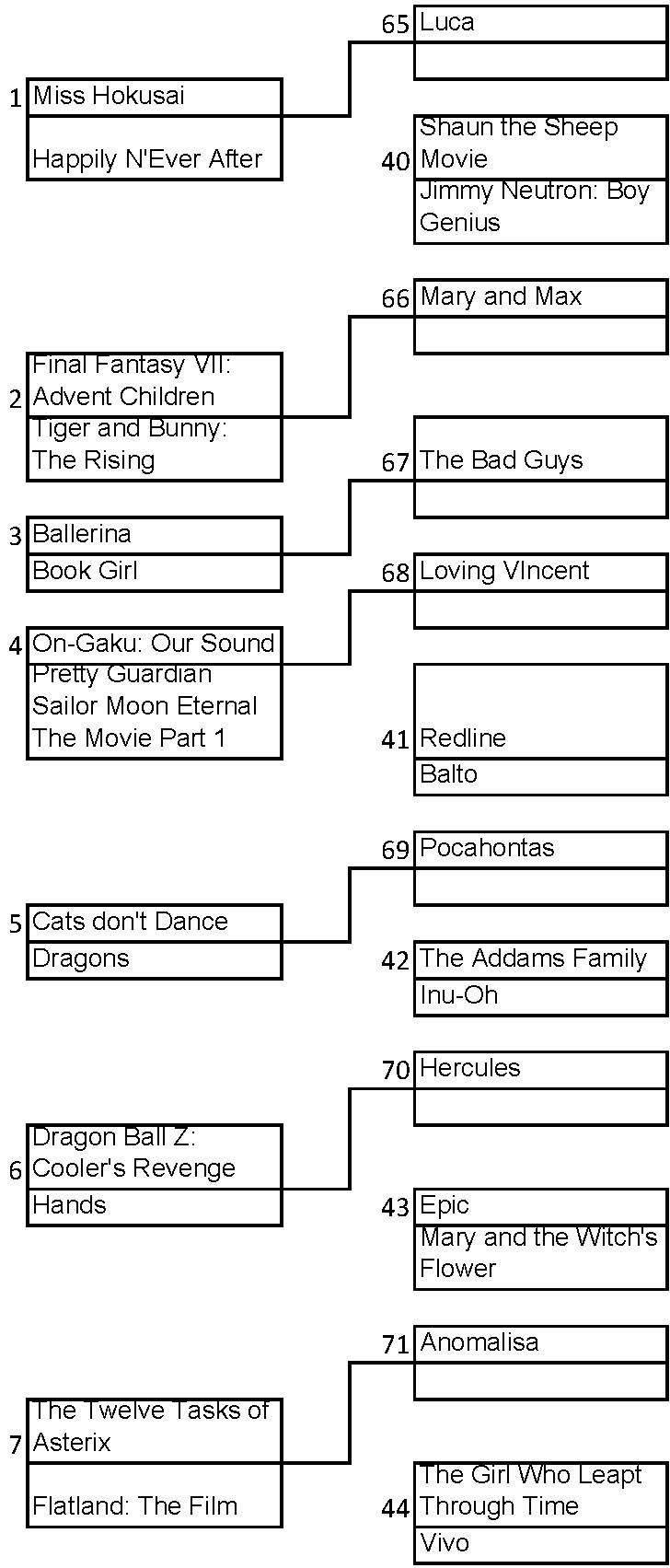
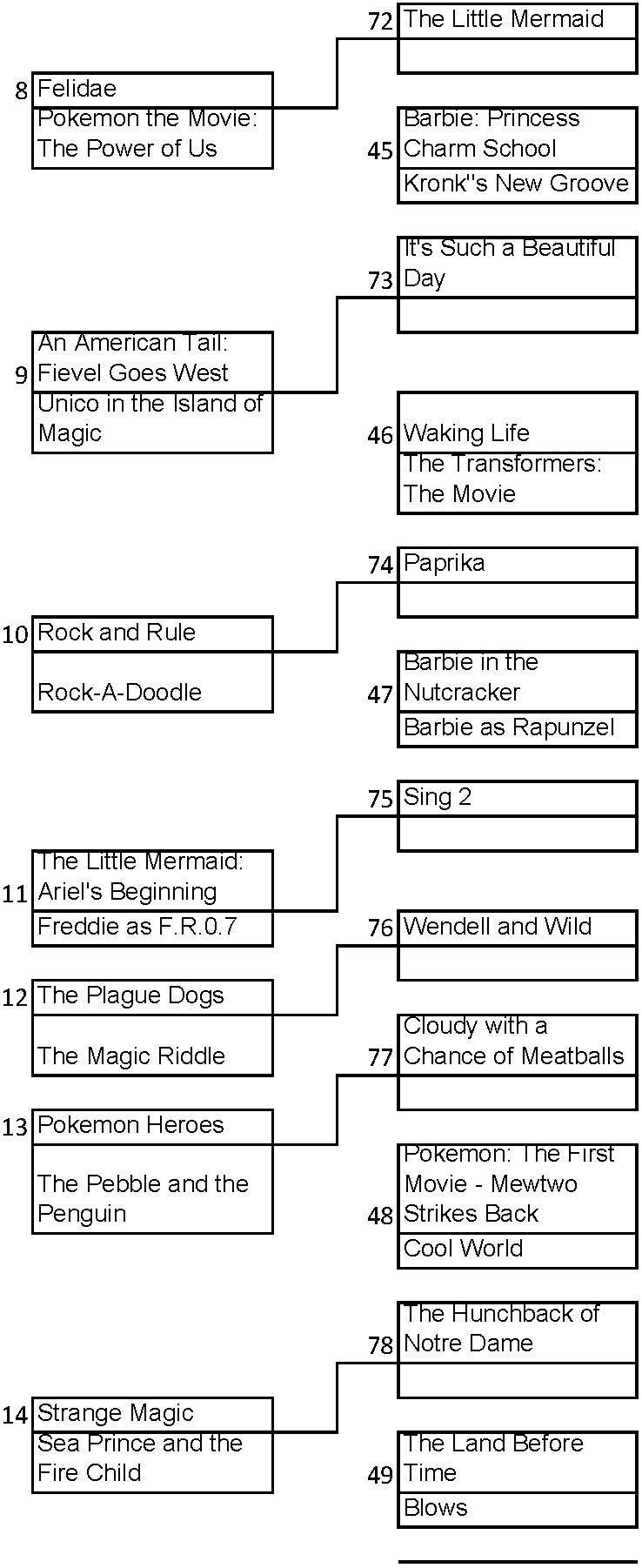
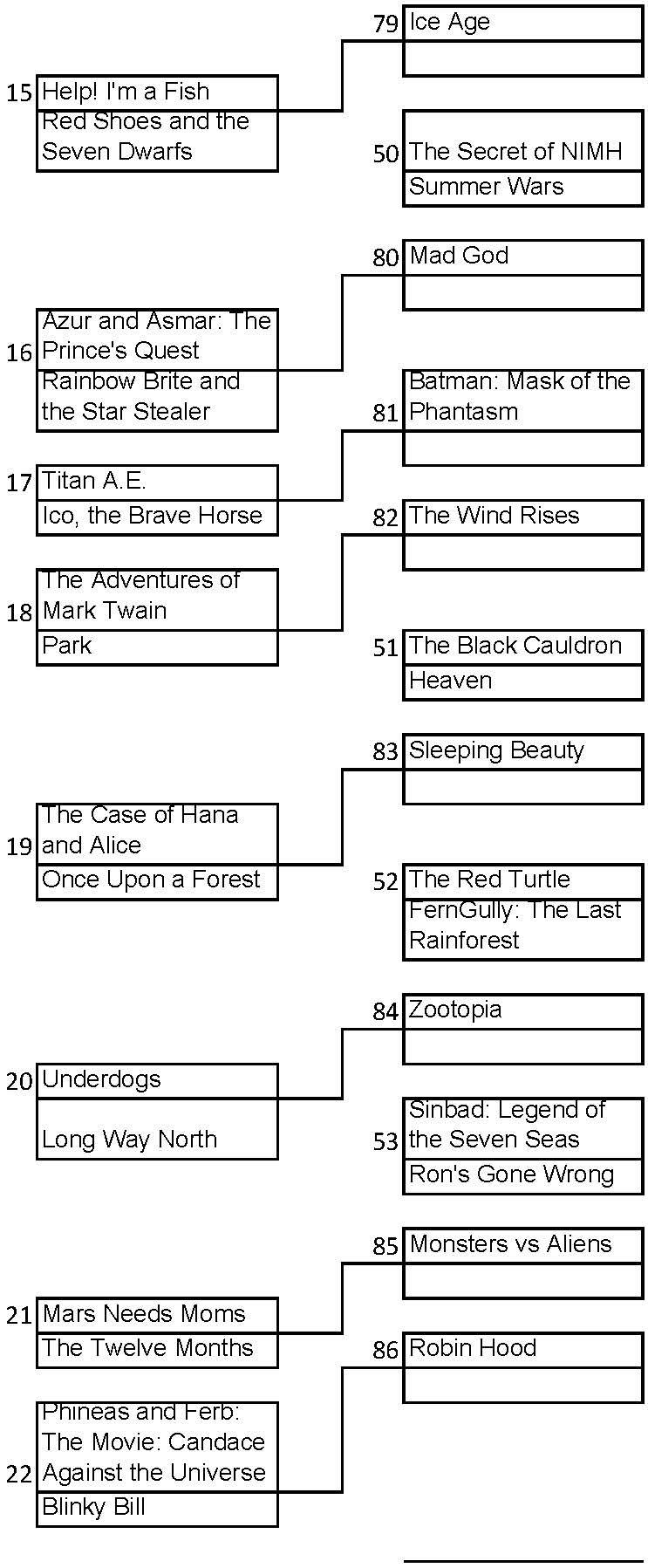
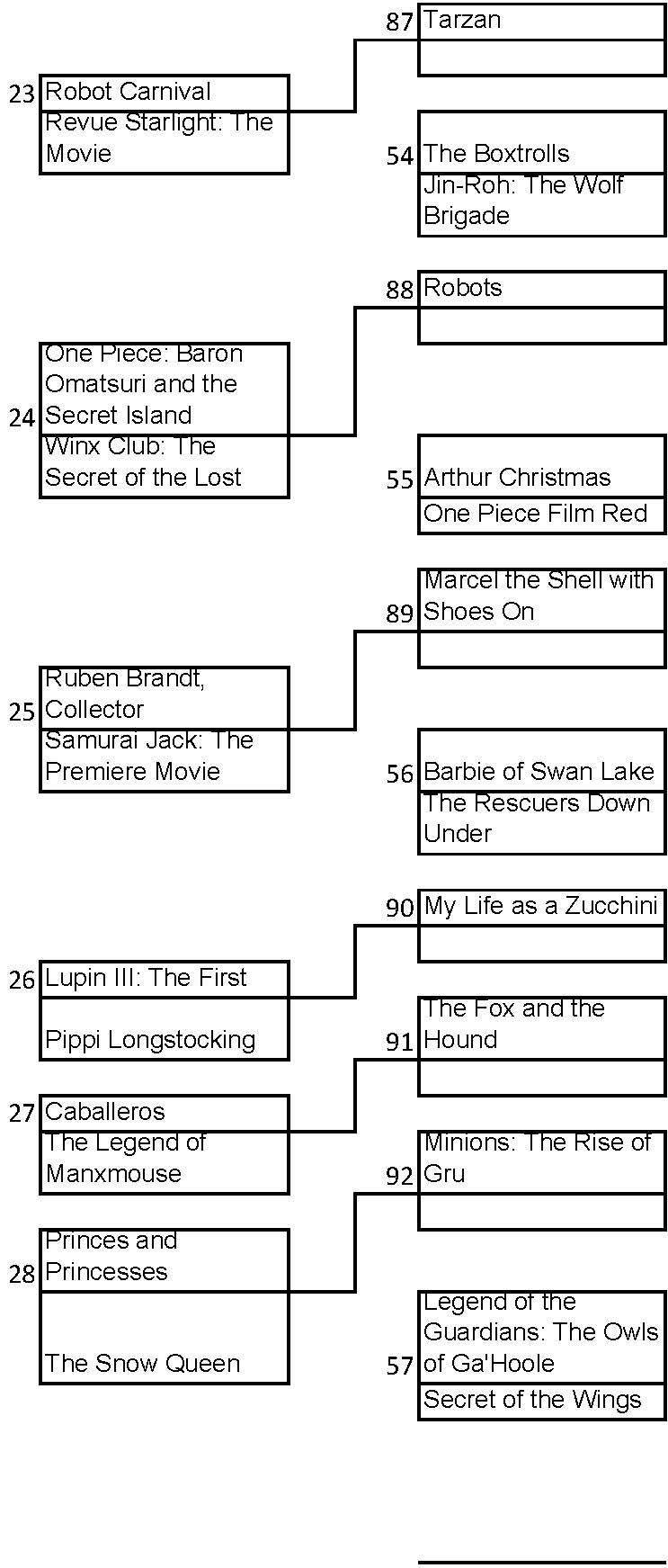
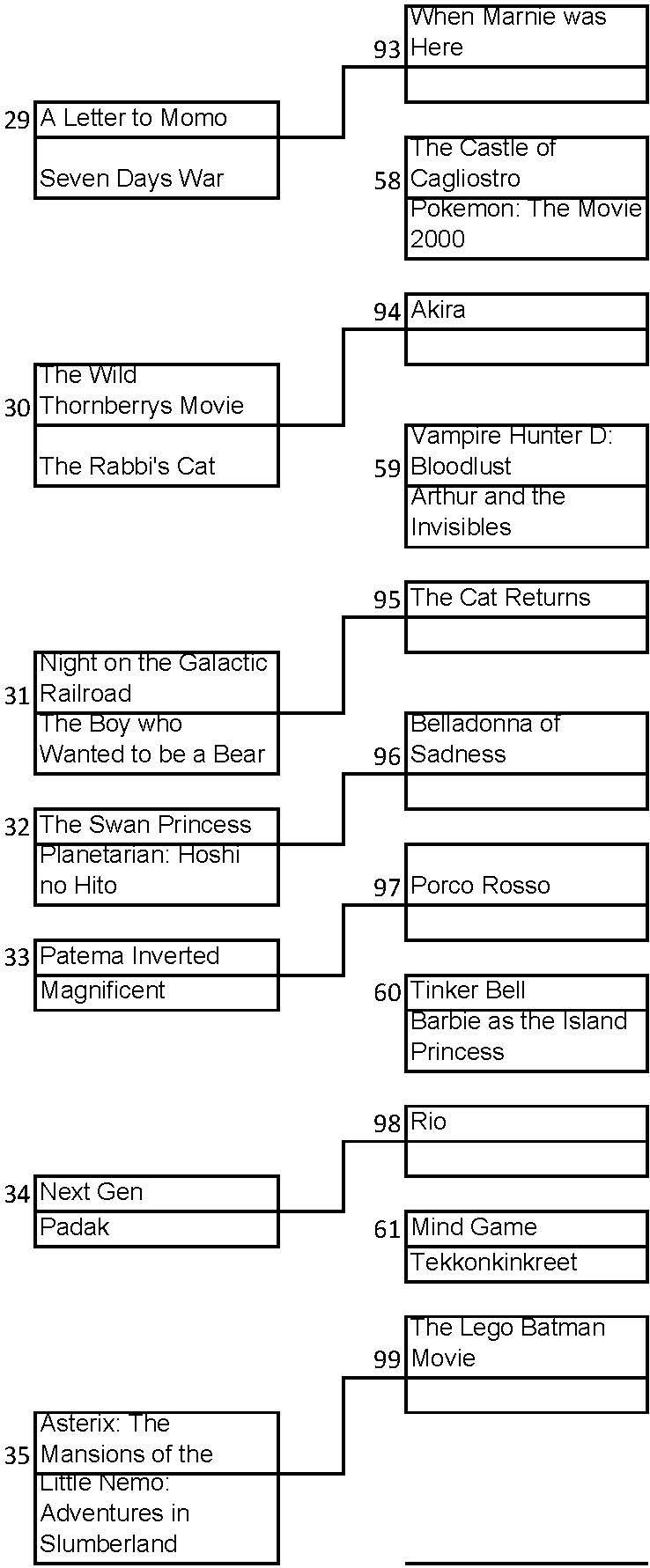
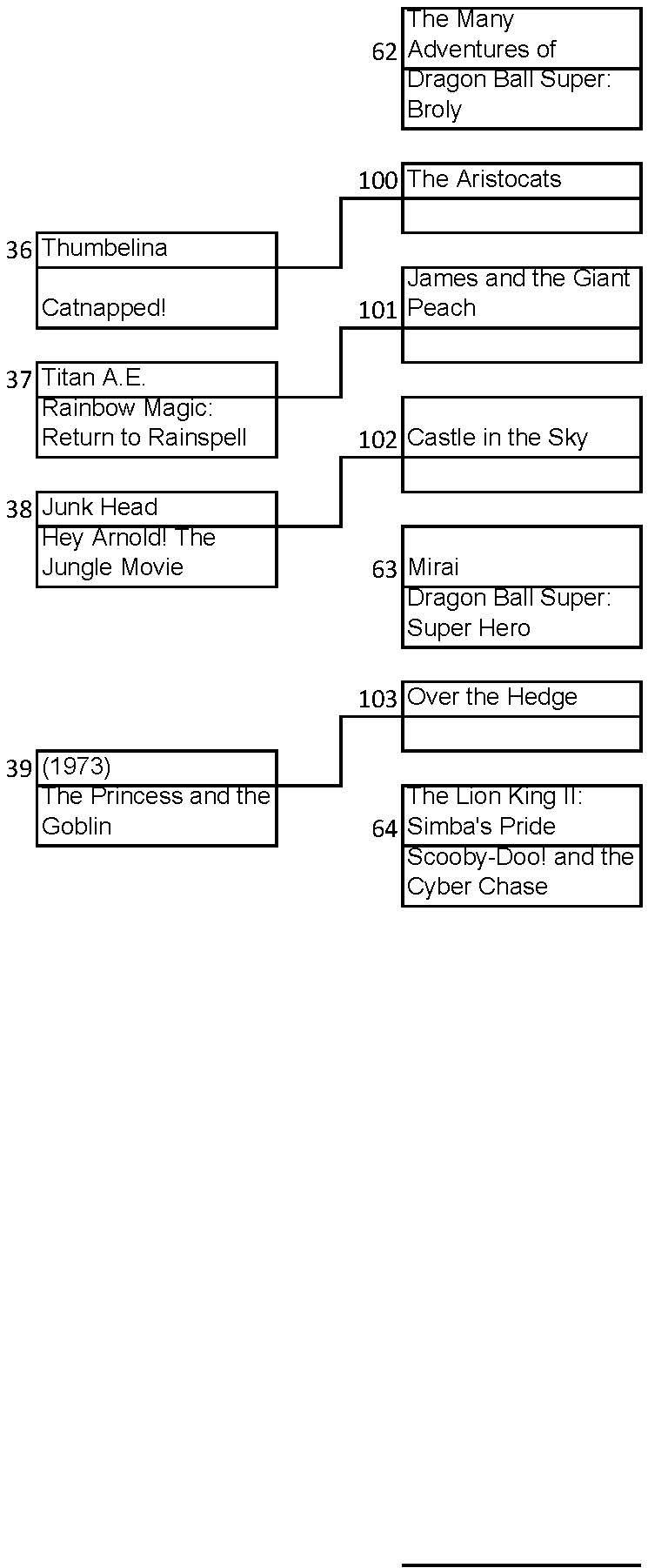
Miss Hokusai vs Happily N'Ever After
Final Fantasy VII: Advent Children vs Tiger and Bunny: The Rising
Ballerina vs Book Girl
On-Gaku: Our Sound vs Pretty Guardian Sailor Moon Eternal The Movie Part 1
Cats don't Dance vs The Flight of Dragons
Dragon Ball Z: Cooler's Revenge vs The Girl Without Hands
The Twelve Tasks of Asterix vs Flatland: The Film
Felidae vs Pokemon the Movie: The Power of Us
An American Tail: Fievel Goes West vs Unico in the Island of Magic
Rock and Rule vs Rock-A-Doodle
The Little Mermaid: Ariel's Beginning vs Freddie as F.R.0.7
The Plague Dogs vs The Magic Riddle
Pokemon Heroes vs The Pebble and the Penguin
Strange Magic vs Sea Prince and the Fire Child
Help! I'm a Fish vs Red Shoes and the Seven Dwarfs
16.Azur and Asmar: The Prince's Quest vs Rainbow Brite and the Star Stealer
17.Titan A.E. vs Ico, the Brave Horse
18.The Adventures of Mark Twain vs A Troll in Central Park
19.The Case of Hana and Alice vs Once Upon a Forest
20.Underdogs vs Long Way North
21.Mars Needs Moms vs The Twelve Months
22.Phineas and Ferb: The Movie: Candace Against the Universe vs Blinky Bill
23.Robot Carnival vs Revue Starlight: The Movie
24.One Piece: Baron Omatsuri and the Secret Island vs Winx Club: The Secret of the Lost Kingdom
25.Ruben Brandt, Collector vs Samurai Jack: The Premiere Movie
26.Lupin III: The First vs Pippi Longstocking
27.The Three Caballeros vs The Legend of Manxmouse
28.Princes and Princesses vs The Snow Queen
29.A Letter to Momo vs Seven Days War
30.The Wild Thornberrys Movie vs The Rabbi's Cat
31.Night on the Galactic Railroad vs The Boy who Wanted to be a Bear
32.The Swan Princess vs Planetarian: Hoshi no Hito
33.Patema Inverted vs Bartok the Magnificent
34.Next Gen vs Padak
35.Asterix: The Mansions of the Gods vs Little Nemo: Adventures in Slumberland
36.Thumbelina vs Catnapped!
37.Early Man vs Rainbow Magic: Return to Rainspell Island
38.Junk Head vs Hey Arnold! The Jungle Movie
39.Charlotte's Web (1973) vs The Princess and the Goblin
40.Shaun the Sheep Movie vs Jimmy Neutron: Boy Genius
41. Redline vs Balto
42. The Addams Family vs Inu-Oh
43. Epic vs Mary and the Witch's Flower
44.The Girl Who Leapt Through Time vs Vivo
45.Barbie: Princess Charm School vs Kronk''s New Groove
46.Waking Life vs The Transformers: The Movie
47.Barbie in the Nutcracker vs Barbie as Rapunzel
48.Pokemon: The First Movie - Mewtwo Strikes Back vs Cool World
49.The Land Before Time vs When the Wind Blows
50.The Secret of NIMH vs Summer Wars
51.The Black Cauldron vs All Dogs go to Heaven
52.The Red Turtle vs FernGully: The Last Rainforest
53.Sinbad: Legend of the Seven Seas vs Ron's Gone Wrong
54.The Boxtrolls vs Jin-Roh: The Wolf Brigade
55.Arthur Christmas vs One Piece Film Red
56.Barbie of Swan Lake vs The Rescuers Down Under
57.Legend of the Guardians: The Owls of Ga'Hoole vs Secret of the Wings
58.The Castle of Cagliostro vs Pokemon: The Movie 2000
59.Vampire Hunter D: Bloodlust vs Arthur and the Invisibles
60.Tinker Bell vs Barbie as the Island Princess
61.Mind Game vs Tekkonkinkreet
62.The Many Adventures of Winnie the Pooh vs Dragon Ball Super: Broly
63.Mirai vs Dragon Ball Super: Super Hero
64.The Lion King II: Simba's Pride vs Scooby-Doo! and the Cyber Chase
26 notes
·
View notes
Note
My Pomefiore Black Sheep Dorm Accessories
Krynienne Draconia

Qin!Viper

Sinbad!Al-Asim

WAAAAH WAIT THEY'RE SO PRETTY!!!
18 notes
·
View notes
Text
The "Balladeer" -Design and lore
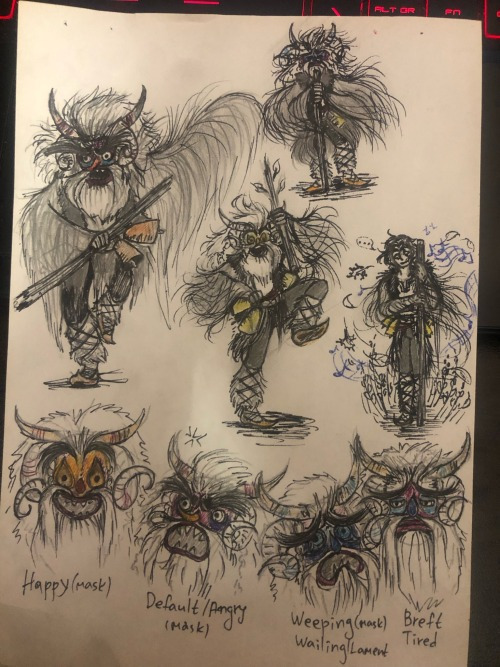
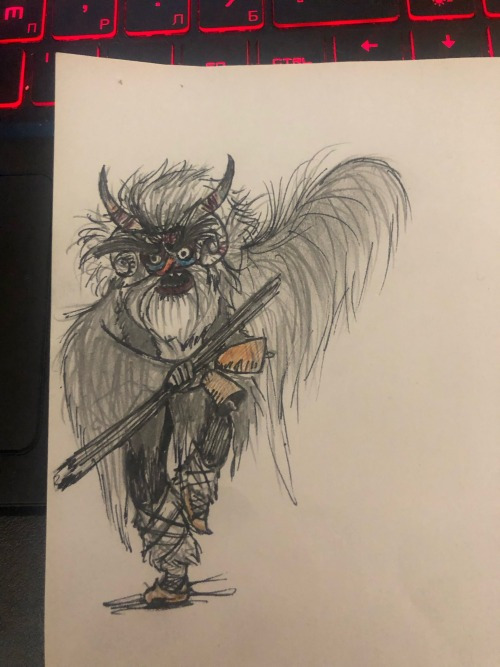


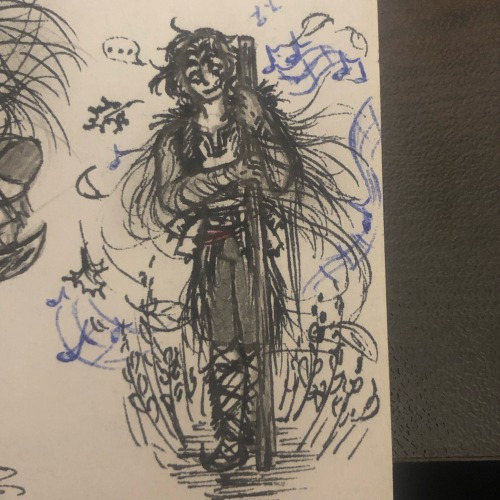


Lore of the Balladeer- "Kuker (Mummer)"
|> Intro (origins?) story |> Resonance hall idle "animations" & "voice lines" |> "Voicelines" -Main theme- In-depth dive - Voice headcannons |> Secondary theme (Battle/Intro theme)
====Resonance hall idles, affinity lines & "voicelines"=========
=-Resonance hall "animations" of the Mummer-=
0 | The Balladeer comes over to the screen/player from the distance, a small 'hop' or 'skip' to his steady strides. The bells on his thick leather belt make mild, friendly 'Clanng!' -'Clang!' -'Clanng!' sound with each movement as he does, punctuating his every unhurried step, along the stead light 'Tap!' -'Tap!' -'Tap!' of his staff. Has his Happy mask on, and then assumes his idle pose-- Holding the sturdy old wood stick with both hands and leaning on it. Like this-


1 | The Missing lets out a carefree, happy laugh as he leaps into a wild dance-- Hops from foot to foot, doing a sort of small 'hop' when lifting a leg where he holds that pose for a second before switching legs/feet; gives 'pauses' in-between where he does a jump in place with both feet together; And has his Happy mask on as he dances, letting out short, sharp cheery whistles and "Hey! Hey! Hey! Hey!", while the cow and sheep bells on belt clang and rattle with his rapid movements. Also grips onto his belt and scarlet sash at his waist with his left hand (not clawed), while his staff in the other (clawed), bringing the stick down as he does his foot from his 'hop' to strike the ground 'Tap-Tap!' as if to emphasize a 'pause' is coming. And then lets out a loud jovial, drawn out yell of "Heeee-E!" and another of those short, sharp whistles, very briefly lifting his mask up to reveal his face for a second at the last 'E!' of his call, revealing he's grinning. (Amused, in good, high-spirits, tiny hint of wistful fondness in his bright grin on that boyishly handsome face of his).
After that Valen heaves a small, quieter and calmer laugh in a chuckle, easing off from his dance to resume his idle pose of leaning on his ash or hickory stick--Like in this image:
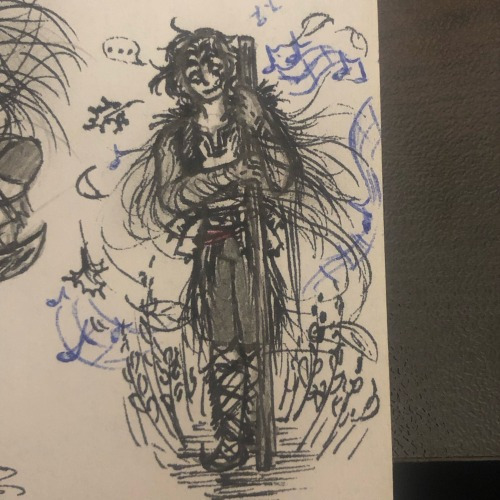
2 | The Dancer is leaning on his stick, relaxed with Happy mask on as he leisurely looks around himself, his bells making soft ringing as he shifts his weight from foot to foot subtly, slightly.
Then he seems to look over his shoulder as if having heard something/someone, and his Happy mask turns to his 'default' Angry one; The Mummer lifts his right hand, the fur of his long sleeve falling back to reveal his clawed hand a little-- And Valen sternly wags his finger to whatever/whoever he's looking at as if to say "Watch it.", or "Behave yourself." then slowly turns his head back to the player/screen, mask shifting back to Happy as he once again is gripping his staff with both hands.
-The Balladeer's voice-lines -
Deploy: Cheerful racket of mildly clattering cow and sheep bells, plus a small short, sharp whistle - Before Happy mask switches to Angry, staff turning to spear like in his story, held like the lowered horns of a bull. Aggressively in intimidation, threatening.
Defeated: "I'm...sorry I..failed...(Rest. We'll try again..)" The quiet, soothingly tender and mournful faint echo to say this (The player has to seriously strain to hear it under Val's strained voice and final 'Clang!' of his bells.) As the Kuker crumbles to his knees, holding onto his staff- a regular sturdy stick again- hunched over, mask going from Angry to sad to Tired, eyes closed.
Ultimate (Applies "Frighten" and makes both front & backline units scatter in terror. Three small red lightning bolts hover over Valen's head to indicate his skill is still active as he chases around the enemies, and the debuff is up. Similar to Sinbad's attack skill. The player can sometimes hear a small furious 'Raaargh!' yell from him, sort of like Grannie Dahnie and her taunts.):
Makes a cacophonous sound that's an amalgamation on furious yell, Grief-filled wailing and cheerful, carefree laughter all at once; This is in conjunction with the loud, aggressive clanging and rattling of the cow and sheep bells on his belt, as the Kuker charges swiftly straight at the enemies, spear lowered.
(Also I think it'd be kinda funny to watch him hop from foot to foot quickly while making this ruckus, like some cartoon nonsense, as he chases after a unit. The enemy hero in question, however, won't be having fun being charged/rushed/chased around by a 'bull'.) Upgrade: Does a small happy dance. (Thanks.)
Victory: "Hey! Hey! Hey! Heeee-E! (heheh.)" Assumes that pose as in his happy dance/first recruitment. The voice echoing underneath his and the bells' 'Clanng!' is mildly amused.
First recruitment: 'Clanng-Clanng-Clanng!'
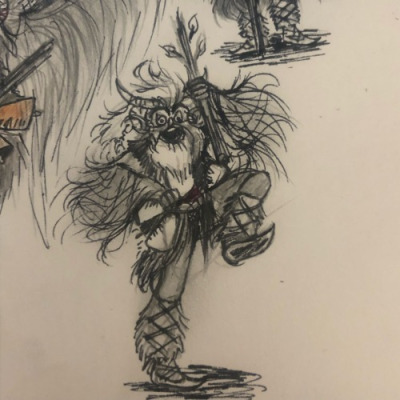
(*sighh.* Be serious.) "Heh." :D Then switches into his angry pose with a slow flourish for dramatic effect-

---Affinity Gift---
Favorite item (Teacup and or flower bouquet): Does a small lively dance then signs 'Thanks! I really like it- Much appreciated!' quickly, then pauses for a second as if suddenly realizing/remembering something and gives a big thumbs up to the player.
General item: Has his happy mask on, gives a small solemn nod while leaning on his staff that he holds with both hands. Then does a small 'Tap-Tap!' with it kind of idly, but a softer tap.
Despised item (Graveborn lantern, Celestial sword and Demon eye): "....." The Happy mask slowly morphs to mildly Angry, as in displeased and disapproving, leaning on his staff as he does like in his idle. But gives a more firm 'Tap-Tap.' with it. His mask is kind of a mix of Angry and Tired in terms of expression.
The Missing is, perhaps, the only Lightbearer unit to have a despised item(s) at all to begin with. Let alone be unhappy with the sword of the Celestials as much as the Hypogeans' amulet.



Official tags for The Balladeer cryptid: The "Balladeer", "Missing", The "Dancer" , project "harbringer" , "Kuker", Demon-Dancer, Demon warden, The Mummer
The other Cryptids' ask blogs |> The Damoiseau - "The Blind prophet" |> The Knave - Arlecchino / The "Mad-Hatter" |> The Marionet - Executioner/ The "Debt-collector" |> The Fair Gentleman / Unbound Will- of wisp
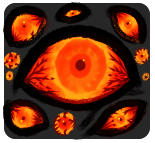





#project “harbringer”#afk valen#afk journey#afk journey fanart?#Cryptid!Valen#“The Balladeer” -Valen/Pirin fusion#mummer#Demon-dancer#Demon warden#“Missing”#“Kuker”#The “Balladeer”#“The Dancer”
6 notes
·
View notes
Photo
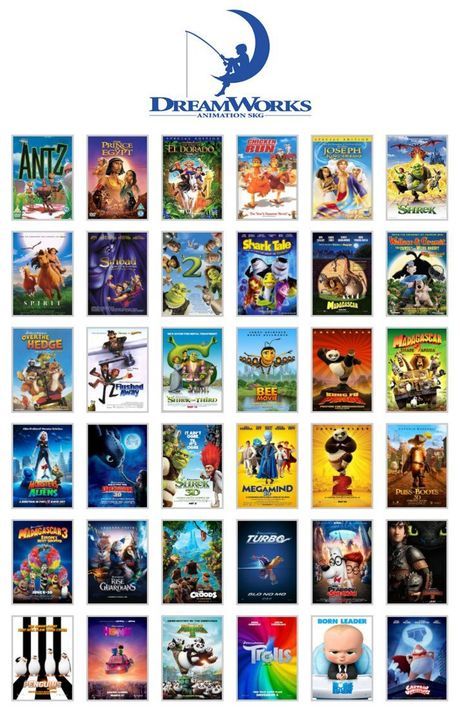
Dreamworks The Croods Franchisees Prehistoric belts cave journel short Prehistoric Dear Diary: World's First Pranks short Prehistoric To Gerard Family Movie Night: Little Red Bronana Bread short Prehistoric to gerard short Prehistoric Prince Of Egypt 1250 BCE Kung Fu Panda Franchisees (1046-256 B.C. Panda Paws short 1046-256 B.C. Sinbad 733 BC and 212 BC How To Train Your Dragon Franchisees 1010 AD Legend Of The Boneknapper Dragon short 1010 AD Dawn Of The Dragon Racers 26 short 1010 AD Bilby short 1010 AD Bird Karma, short 1010 AD Friend vs Food short 1010 AD The Secret Sheep Societ short 1010 AD Shrek Franchisees 14th to 17th century Shrek In The Swamp Karaoke Dance Party short 14th to 17th century Far Far Away Idol short 14th to 17th century Shrek's Yule Log short 14th to 17th century Donkey's Caroling Christmas-tacular short 14th to 17th century Puss In Boots: The Three Diablos short 14th to 17th century Road To El Dorado 1512 Megamind 1939 Megamind The Button Of Doom 1939 Spirit 1 1860s Spirit 2 1870 Wallace And Gromit Curse Of The Were Rabbit 1950s Stage Fright short 1950s Chicken Run 1950s B.O.B.'s Big Break short 1968 Boss Baby Franchise 1980s The Boss Baby And Tim's Treasure Hunt Through Time short 1980s Tiny Diamond Goes Back To School short 1980s Precious Templeton: A Pony Tale short 1980s Antz 1998 Captain Under Pants 1997-200s Shark Tale 2004 Club Oscar short 2004 Madagascar Franchise 2005 Penguins in A Christmas Caper short 2005 the enchanted island of madagascar short 2005 Over The Hedge 2006 Hammy's Boomerang Adventure short 2006 Flushed Away 2006 Bee Movie 2007 Monster Vs Aliens 2009 Rise Of The Guardians 2012 Turbo 2013 Mr Peabody And Sherman 2014 Home 2016 Boovies: This Is Being Boov short 2016 Boovies: Almost Hom short 2016 Boovies: Testing Lab short 2016 Trolls Franchise 2016 Abominable 2019 Marooned shorts 2019 Show & Tell shorts 2019
3 notes
·
View notes
Text

Come Preparare il Presepe Italiano How to Prepare an Italian Nativity Scene Un Natale Italiano: Decorazioni Ovunque!An Italian Christmas: Decorations Everywhere! Come potete vedere, sto preparando la casa per il Natale. Ho appena finito di decorare l’albero con i miei figli. Nel corso degli anni ho collezionato tanti ornamenti e ormai è pieno di decorazioni. Anche il mio cane, Sinbad, è adornato con campanelle! C’è un angelo di Natale, decorazioni per la tavola e persino cuscini natalizi. In cucina ci sono piatti con immagini di Babbo Natale.As you can see, I’m preparing the house for Christmas. I just finished decorating the tree with my children. Over the years, I’ve collected so many ornaments that it’s now full of decorations. Even my dog, Sinbad, is adorned with bells! There’s a Christmas angel, table decorations, and even Christmas-themed pillows. In the kitchen, there are plates with pictures of Santa Claus. Luci, Canti e Film ClassiciLights, Carols, and Classic Movies Adoro decorare la casa con le lucine. Sembra che ogni angolo della casa abbia un tocco natalizio. Sul camino c’è una collezione di bambole di Babbo Natale. Davanti al caminetto c’è un cesto con stelle di Natale. Mentre lavoro, ascolto e canto le canzoni di Natale, anche se sono un po’ stonata. Mi piace anche guardare i vecchi film come La vita è meravigliosa di Jimmy Stewart e Il miracolo della 34ª strada.I love decorating the house with fairy lights. It feels like every corner of the house has a touch of Christmas. On the mantelpiece is a collection of Santa Claus dolls. In front of the fireplace, there’s a basket with poinsettias. While I work, I listen to and sing Christmas carols, even if I’m a bit off-key. I also enjoy watching classic holiday movies like It’s a Wonderful Life with Jimmy Stewart and Miracle on 34th Street. Come si prepara la casa per Natale https://youtu.be/WEk-ghxdvmM Prepariamo il Presepe!Let’s Set Up the Nativity Scene! Ora mi preparo per montare il Presepe. Siete pronti ad aiutarmi? Ogni anno ne preparo uno con statuine italiane. Costruisco l’ambientazione con carta speciale stampata in Italia, sassolini e muschio raccolti dal giardino, e paglia. Come struttura uso una scatola da scarpe trovata in fondo all’armadio.Now I’m getting ready to assemble the Presepe. Are you ready to help me? Every year, I create one using Italian figurines. I build the setting with special paper printed in Italy, small stones, moss from the garden, and straw. For the structure, I use a shoebox I found at the bottom of the closet. Dettagli che ContanoLet’s Set Up the Nativity Scene! Per dare un tocco naturale, accartoccio un po’ la carta, così sembra di vedere rocce, campi e grotte. Quest’anno ho aggiunto una novità: un piccolo stagno fatto di carta stagnola. Una volta completata la base, aggiungo muschio, paglia e sassolini in modo casuale.To give it a natural look, I crumple the paper slightly, making it resemble rocks, fields, and caves. This year, I added something new: a small pond made from tin foil. Once the base is done, I scatter moss, straw, and stones casually. Il Tocco Finale: Gesù BambinoThe Final Touch: Baby Jesus Adesso è tutto pronto per le statuine di Maria, Giuseppe, i pastori, le pecore, e l’angelo. Metto una luce dietro l’angelo per illuminare la scena. Secondo tradizione, Gesù Bambino non viene messo prima della Vigilia di Natale, e i Re Magi arrivano solo il 6 gennaio per celebrare l’Epifania.Now it’s time to place the figurines of Mary, Joseph, the shepherds, the sheep, and the angel. I put a light behind the angel to illuminate the scene. As per tradition, Baby Jesus isn’t added until Christmas Eve, and the Magi arrive only on January 6th for the Epiphany. Tu scendi dalle stelle — una canzone nataliziaYou Come Down from the Stars — an Italian Christmas Carol È uno dei canti natalizi italiani più amati, cantato in tutta Italia durante il periodo delle festività. È una parte integrante delle tradizioni natalizie italiane. Spesso viene cantato durante i ritrovi familiari, in chiesa e attorno al Presepe.It is one of the most cherished Italian Christmas carols, sung across Italy during the festive season. It’s an integral part of Italian Christmas traditions. It’s often sung during family gatherings, in churches, and around the Presepe (Nativity scene). https://youtu.be/kK932hwc8UA Tu scendi dalle stelle,O Re del Cielo,E vieni in una grottaAl freddo e al gelo.(You come down from the stars,Oh King of Heaven,And you come to a caveIn the cold and frost.) Read the full article
0 notes
Text

I LOVE PLAYING PRETEND. ╱ ERIS , GODDESS OF DISCORD.
a study no , an art of knowing one's function , their design, their nature , and reveling in it. discarding morality of man , knowing full well the butcher doesn't care for the protest of sheep , and the disaster cares even less for the cries of its victims.
SIDEBLOG TO HALFSOVL. antis + minors DNI.
expect typical greek mythology i.e. mentions of incest, violence, all that shit will it be graphically written? maybe, probably. if i feel like it.
eris is a shapeshifter, a liar -- even the form you see is just a projection to be altered at will.
we do not need to be mutuals to write! i might opt out of following back on here but i will engage with your posts and be vocal about my interest!
she is heavily based off mythology, sinbad adapations, and other mixed media influences.
0 notes
Text
The life of a pirate is wonderful (a translated fanfic of Sinbad: Pirates of the Seven Storms)
“Now,” Sinbad began with a breath. - Now all paths are open to us…
He gestured broadly across the horizon. The team looked at the captain's inspired antics with the usual expression of skeptical expectation on their faces.
“With all these treasures, we can become whatever we want - either merchants or fugitives.” We can buy a license in Tortuga and become real pirates! Or buy yourself a house and raise sheep! Or from all this gold we can cast a hefty anchor…
Sinbad's eyes sparkled in a suspiciously familiar way, and Mansur sighed heavily.
“First of all,” he said, “we need to buy a new ship - and then we’ll think about what to do next, okay?”
The twins showed their thumbs up, Shrimp smiled in agreement.
“Great plan,” Solara nodded and turned her gaze to a possible new member of the team. - And who are you?
Yes, yes. Evil spirit of vengeance, Maaba. I’m pretty harmless actually,” Maaba giggled and clung to Shrimp’s shoulder.
-Are you with us now? — Solara clarified, just in case.
Where should I go from Skeleton Island? — Maaba was sincerely surprised. Solara thought for a moment, but soon smiled:
“Okay then, Maaba, welcome aboard.”
Well, thank you! — Maaba closed her eyes contentedly and described a circle in the air. “I usually sleep in this jug,” she lifted the copper jug above the deck and handed it to Shrimp: “Let it stay with you.”
The shrimp was confused, but held the jug.
“Nice,” concluded Solara. “Now let’s all rest, it’s been a hard day.”
So everyone dispersed, leaving the captain on the deck, depressed by such inattention.
-You're Shrimp, right? I wouldn't want to trust my jug to just anyone, so take good care of it.
Shrimp nodded seriously and carefully placed the jug on the box under his bed.
“I know you don’t really like to talk, huh?” But you will have to watch me and look after me - feed me, preferably dates, play with me…
The Shrimp smiled and beckoned the Rat towards him. The rat squeaked and climbed onto his lap. The shrimp stroked the Rat's white fur and looked at Maaba, saying, look, I know what it means to care for, feed and play.
“More entertainment,” Maaba was about to frown, but Shrimp extended his hand, and she obediently sat on his palm. Shrimp transferred it from his palm to his shoulder, and he took out a flute from a knitted case, brought it to his mouth and began to play. The melody flowed smoothly, tenderly, melodiously. Maaba sighed happily and pressed her side against Shrimp's neck; the sound was so enchanting that she closed her eyes in pleasure.
“Okay… In the evening we’ll play my game,” she promised. - Here you are, what would you like to do now, with such riches?
The shrimp froze, the melody stopped. He took the flute away from his face for a moment and showed the instrument to Maaba so that she could examine it.
Just to play? — Maaba clarified, looking at the new, worn flute. - You know, I could do something for you. To fulfill some tiny desire… It’s not difficult for me.
Shrimp shook his head.
No? - Maaba sighed upset. - Why so? Who are you going to play for?
Shrimp shrugged.
“For everyone,” he said briefly and again brought the flute to his lips, blew softly, and began to finger it with his fingers. A fresh, shimmering sound poured out.
Maaba purred softly, rolled closer to the warm skin and curled up into a ball.
“And just being at sea is also not bad at all,” she muttered. - You swim wherever you want, do whatever you want… Beauty.
Maaba, of course, didn’t see this, but Shrimp’s eyes sparkled cheerfully. He did not stop to say something out loud, and the melody, soothing like the rustling of waves, went on and on.
0 notes
Text
SINBAD AND THE EYE OF THE TIGER (1977) – Episode 186 – Decades Of Horror 1970s
“The only good thing about this port is the inn of Abu Jamil the Squint, who, for six months, I have been dreaming of his roasted sheep’s eyes.” Ah, yes. Who wouldn’t sail the seven seas for roasted sheep’s eyes? Join your faithful Grue Crew – Doc Rotten, Chad Hunt, Bill Mulligan, and Jeff Mohr – as they take in the third of Ray Harryhausen’s three Sinbad films, Sinbad and the Eye of the Tiger(1977).
Decades of Horror 1970s Episode 186 – Sinbad and the Eye of the Tiger (1977)
Join the Crew on the Gruesome Magazine YouTube channel! Subscribe today! And click the alert to get notified of new content! https://youtube.com/gruesomemagazine
Sinbad The Sailor sails to deliver a cursed prince to a dangerous island in the face of deadly opposition from a powerful witch.
Director: Sam Wanamaker
Writers: Beverley Cross (screenplay & story); Ray Harryhausen (story)
Selected cast:
Patrick Wayne as Sinbad
Taryn Power as Dione
Margaret Whiting as Zenobia
Jane Seymour as Farah
Patrick Troughton as Melanthius
Kurt Christian as Rafi
Nadim Sawalha as Hassan
Damien Thomas as Kassim
Bruno Barnabe as Balsora
Bernard Kay as Zabid
Salami Coker as Maroof
David Sterne as Aboo-Seer
Peter Mayhew as Minoton
Are you ready for more Ray Harryhausen? More Sindbad? Maybe you prefer Patrick Wayne or Jane Seymour? Regardless, the Grue-Crew set sail for Sinbad and the Eye of the Tiger (1977) on the latest episode of Decades of Horror 1970s. The stop-motion creatures for the third Harryhausen Sinbad film include the Troglodyte, the Minoton (a magical large bronze minotaur brought to life by an evil witch), a large baboon, a large wasp, a giant walrus, a trio of “ghouls,” and a sabretooth tiger. The film is full of crappy dialog, rough editing, lackluster direction, and wooden acting… all saved by Harryhausen’s wonderful effects work. Let’s dive in!
You might find these other Decades of Horror episodes on Ray Harryhausen films interesting:
THE BEAST FROM 20,000 FATHOMS (1953) – Episode 69 – Decades Of Horror: The Classic Era
THE VALLEY OF GWANGI (1969) – Episode 116 – Decades Of Horror: The Classic Era
THE 7TH VOYAGE OF SINBAD (1958) – Episode 144 – Decades Of Horror: The Classic Era
THE GOLDEN VOYAGE OF SINBAD (1973) – Episode 173 – Decades Of Horror 1970s
CLASH OF THE TITANS (1981) – Episode 210 – Decades Of Horror 1980s
At the time of this writing, Sinbad and the Eye of the Tiger is available to stream from Crackle, Cultpix, Fubo TV, and various PPV sources. It is also available on Blu-ray as a stand-alone from Indicator or as part of Ray Harryhausen – The Ultimate 7 Film Collection from Via Vision.
Gruesome Magazine’s Decades of Horror 1970s is part of the Decades of Horror two-week rotation with The Classic Era and the 1980s. In two weeks, the next episode, chosen by Chad, will be John Carpenter’s Dark Star (1974). That should be a fun one!
We want to hear from you – the coolest, grooviest fans: comment on the site or email the Decades of Horror 1970s podcast hosts at [email protected].
Check out this episode!
1 note
·
View note
Text
It was a usual evening when one of our veteran members asked “what would Sinbad look like as a sheep?” and proceed to make a drawing of him in MS Paint.

by Sadi @kadajchan

by Jade @jelainethefirst

by Rei @soreita

by Haru/Kouen @harooksandbishops
#sinbad#sinbad squad shenanigans#sinbad!sheep#im not even#what is dis#why did I even participate#animal mutation?#jelainethefirst
22 notes
·
View notes
Text

Sinbaa conqueror of the seven sheeps.
26 notes
·
View notes
Photo

I was a liberated woman long before there was a name for it.
- Peggy Guggenheim
Peggy Guggenheim was an eccentric art collector, born August 26, 1898 to Florette Seligman, of the banking Seligmans, and Benjamin Guggenheim, of the mining Guggenheims. Art patronage seemed to run deep in the family, as did their pockets. Her uncle was Solomon R. Guggenheim.
Amassing one of the most extensive collections in the world, she did not consider herself a mere collector, and in her own words, "I dedicated myself to my collection. I made it my life's work. I am not an art collector. I am a museum."
However, Peggy considered herself a black sheep in the Guggenheim family. When her father died on the Titanic, his businesses lost some money, and, although her family’s wealth still rivaled that of a small country, she felt poor in comparison to the rest of her family. In her youth, she rebelled against her bourgeois roots by shaving off her eyebrows.
Peggy received her inheritance at the age of 21 and started working as a shop assistant at the shop Sunwise Turn in Manhattan. Here, she adopted socialist ideals, further rejecting the wealth she was born into, and began her patronage of experimental art.
In 1920, she moved to Paris, befriending avant-garde writers and painters including Romaine Brooks, Djuna Barns, and Natalie Barney. At the age of 23, she lost her virginity to writer Laurence Vail, who was known as “the king of bohemians." They married in 1922, had two children, Sinbad and Peegan, and divorced in 1928.

Her lasting legacy is the Peggy Guggenheim Collection in Venice, which holds the collection she amassed throughout her lifetime in the unfinished palazzo that she resided in, but before establishing the museum she owned several galleries.
The Guggenheim Jeune was opened in 1938 in New York with the inheritance her mother left her. It was a modern art museum and, although critically acclaimed, ended up with a net loss. It was later rebranded as contemporary instead of modern, and Peggy began working with art historian Herbert Read on plans for a Museum of Modern Art in London. In 1939, after closing the Guggenheim Jeune, she returned to Paris with a shopping list of artworks in hand. However, World War II interrupted her plans. She was undeterred, aiming to buy a piece a day and at least one from every artist on the list Read gave her.

After the invasion of Paris in 1940, Peggy returned to New York, packing up her collection along with her casserole dishes and household bedding. In 1942 she married Max Ernst and opened the Art of this Century Gallery. The gallery set itself apart by being a mixture of a private collection and a public gallery, and it became quite popular for a non-commercial gallery. The architecture, designed by Frederick Keisler, was also unique. The paintings were mounted on the wall and patrons were encouraged to manipulate the displays and physically engage with the art. One critic commented on the gallery’s intentions to “desanctify the art, treat it more like, say, books in a reading room."
Peggy often chose to help artists who were struggling and the controversial shows were intended to shock. One of the most notable exhibitions at the gallery is the 'Exhibition of 31 Artists'. The 31 artists were all women, most of which were her own personal friends and family. Also in attendance was Dorothea Tanning, the woman Ernst left her for, about which she later remarked that it should have been an exhibition of 30 instead of 31.
Peggy lived a pretty open life, releasing all the dirty details in her tell-all autobiography "Out of this Century." The title was a play on the phrase “art of this century” and the title of the original manuscript was “Five Husbands and Some Other Men." Alas, the book received negative reviews from critics who mocked her by referring to it as “Out of Her Head” instead. Rude.
Wanting a fresh start, she closed her gallery in 1947 and moved to Venice. In Venice, she was a celebrity. There, she was known for her whimsical dress, her signature butterfly sunglasses designed by Edward Melcarth, her posse of dogs that accompanied her everywhere, and her preferred method of transportation, the gondola.

Guggenheim became an early model of the contemporary art celebrity, as one critic noted, "Even her sunglasses made news." And indeed, an Italian company launched a limited-edition eyewear line inspired by Guggenheim in 2014.
She continued to collect art and was bestowed an Honorary Citizenship by the city of Venice. In 1951, she turned her house, the Palazzo Venier dei Leoni, into a public museum, and loaned her collection to museums across Europe and America. Currently, the Palazzo Vernier dei Leoni permanently houses the U.S. exhibition during the Venice biennale, is the second most visited museum in Venice, and the most visited museum of modern art in Italy.
94 notes
·
View notes
Text
Sonic and the Secret Rings (2007) Story Review

Disclaimer: I will be judging this game by the plot and writing, not the gameplay.
Introduction
Greetings, mortals! For today's review, we'll be looking at what is often considered to be the black sheep of the five main Dark Era games, Sonic and the Secret Rings.
This is part of a series of reviews in which I’ll be going into slightly more detail about my thoughts on the main series Sonic game storylines, and why I think they're either well written and engaging, or an absolute trainwreck (or somewhere in-between). I’ll be giving my stance on the character portrayals, visuals, soundtracks, voice actors, and what themes/messages they had to offer. Keep in mind that these are just my own personal thoughts. Whether you agree or disagree, feel free to share your own thoughts and opinions!
Anyway, let us begin! ^^
Plot
Erazor Djinn is fed up with being the genie from Aladdin, so he starts erasing the Arabian Nights book he is trapped in. Shahra calls out for Sonic for help to fight against Erazor Djinn.
Characters
I think Sonic's personality was perfectly captured here. He's cocky, stubborn, but heroic, badass, caring for the people he helps and his friends. I like that Sonic didn't command Shahra to not hand Erazor the World Rings. That he instead told her to do what she thought was right. It was a subtle thing but very appreciated, and says a lot about Sonic and his character. I also like how Sonic is so sarcastic and hilarious in this game. He has some brilliant lines in this, and unlike the cringey cheesy scripts he's been getting since Colors, his lines were genuinely funny, and it made him very entertaining to watch.
Shahra, in my opinion, is what Elise should have been. Not only does she work better as a traveling companion, but Sonic gives her the same advice of "Why so glum? You should smile more," but it feels more genuine, partly because there's no forced romantic undertones, Sonic's just trying to cheer her up. It also helps that Sonic's personality isn't muted, like it was in 06. He's the same Sonic that we've come to expect from the Adventure/Dark Eras.
Out of all the Dark Era villains, I think Erazor Djinn is somewhat underdeveloped. He's just the most generic bad guy ever without an interesting backstory. He had potential though, and he does have his moments. It's also implied that he was in a relationship with Shahra that went south, but it's never fully elaborated on.
I thought it was interesting seeing what roles Sonic's friends take in the Arabian Nights, like Tails as Ali Baba, and Knuckles as Sinbad just to name a few.
Visuals
I think the visual presentation is pretty well done, and I like how the cutscenes of this game and Black Knight look like a storybook. It seems very fitting to me. The CGI cutscenes in the beginning and end look fantastic as well.
Soundtrack
To be honest, I find the soundtrack to be kind of forgettable compared to the other Sonic game soundtracks. However, the main theme, Seven Rings In Hand, is really good in my opinion, and the ending theme, Worth a Chance, legit sounds like a wedding song, and a touching one at that.
One thing I loved that Dark Era Sonic did was that pretty much every mainline game, from ShTH all the way up to Black Knight, they would have a sad, emotional and awesome song play in the credits. I really wish I could go back to these days. These games were so awesome. Now they're just kiddy, boring and uninteresting.
Voice Acting
As always, Jason Griffith nails Sonic, and Bella Hudson was fantastic as Shahra. Peter Cormican really hammed it up as Erazor Djinn. He sounded like he was clearly enjoying the role. Amy Palant (Ali Baba), Dan Green (Sinbad) and Mike Pollock (King Shahryar) were all great as well.
Theme/Message
To be honest, I'm not sure what the theme/message of Secret Rings is exactly, but from what I could gather, I assume that the theme/message of the story is don't be ashamed about who you are, mainly due to Erazor Djinn and Sonic's relationship. Sonic knows who he is and is proud of it, but he is called a "rat" by Erazor Djinn, who was the genie from Aladdin but he chose not to be. Sonic is proud of who he is, but Erazor Djinn is the opposite. I'll admit I had a hard time trying to figure out what the theme/message of Secret Rings is. The tissue jokes at the beginning and end were apparently more important for the writers than the theme/message of the story.
Conclusion
Secret Rings may be the weakest of the five main Dark Era games in terms of writing quality, but I still think it's a decent story overall. The idea of Sonic exploring the world of the Arabian Nights is quite interesting, but I do feel that it could have been executed a lot better. It does have its moments though, and it is certainly better than any of the Meta Era games.
My final score:
3.5/5 (Okay)
8 notes
·
View notes
Note
Dorms for My Black Sheep Siblings
Celestine: Ramshackle
Glitchy!Shroud: Ramshackle
Namami!Older!Bucchi
Dorm: Disamonia (when he went)
Sinbad!Al-Asim
Dorm: Pomefiore
Qin!Viper
Dorm: Pomefiore
Barbie!LeBlanche
Dorm: N/A (goes to RSA)
Sora!Rielle
Dorm: N/A (goes to RSA)
Aponia!Flamme
Dorm: Ignihyde
Alhaitham!Trappola
Dorm(s): Heartslabyul (formerly), Ramshackle (current)
Fluttershy!Clover
Dorm: Heartslabyul
Punk!Peach!Hunt
Dorm: Pomefiore (formerly), Ramshackle (current)
Okay, but Sinbad!Asim and Qin!Viper being in Pomefiore SENDS ME-- /pos
Like, I can see Vil looking at both Asims in Book 5 and being like "great, now I have to deal with both of you at once." And Qin!Viper's presence alone is just grating to Jamil during all of Book 5 BAHAHAHA
7 notes
·
View notes
Text
I can’t remember my first interactive experience. Maybe Choose Your Adventure stories from the 80’s - both in print and on a juddering IBM. I wasted a lot of hours with Sonic on a Gameboy circa 1993. Much more recently (December 2020) I was blown away by the Ray Harryhausen exhibition at the National Gallery of Scotland.
The exhibition’s purpose was to celebrate 100 years of the artist, showcase his puppets, contextualise his work in its era, and recognise how he influenced stop-frame animation. Ferocious skeletons and towering cyclops are a childhood mainstay of mine, when there were 4 channels on the telly and their Saturday afternoon schedules were always films like The 7th Voyage of Sinbad and Clash of the Titans. So, I was excited to see his work on display as I write for and have an interest in animation, but was surprised when it was the interactive elements that bowled me over.
In one spot multiple screens hung, inviting visitors to step in and be transported to a 50’s set to see how these early animated films were layered, and the order of a shoot. Elsewhere, Playdead, a Glaswegian company adept at all things animated, had designed a narrative played out by a few iconic Harryhausen characters projected onto exhibit slabs between which the story moved. It was a touch of magic, the kind of magic that animation always brings to the table. Or slab. A final stop on a green screen set with sword-wielding skeletons and a dragon in a Sinbad-style ruined city topped off the physical exhibition, but another thread, perhaps under-marketed, was a series of online workshops in conjunction with Aardman Animation. The Aardman facilitators discussed how Harryhausen pushed the limits of his field, which techniques remain unchanged, and how a stop motion animation set works, reinforcing what had been communicated in text at the Gallery as well as teaching us how to make a Gromit and Shaun the Sheep.
It’s a real treat seeing behind the scenes of pioneering films that influenced the likes of Star Wars, Jurassic Park, and Aardman (all themselves pioneers in my opinion) and it was fun, light-hearted, surprising, and genuinely educational. I’m a big fan of learning for all, and believe that museums and galleries can be at the heart of it if all exhibitions were as engaging and broadly appealing as this. So, in a way, Ray Harryhausen is still pioneering, 100 years later.
5 notes
·
View notes
Text
Art Patrons: Peggy Guggenheim

[Venice. Mrs. Peggy Guggenheim in her palace on the Grand Canal, 1950 by David Seymour]
Peggy Guggenheim was an eccentric art collector (and Virgo), born August 26, 1898 to Florette Seligman, of the banking Seligmans, and Benjamin Guggenheim, of the mining Guggenheims. Art patronage seemed to run deep in the family, as did their pockets. Her uncle was Solomon R. Guggenheim (yes, that Solomon R. Guggenheim.)
Amassing one of the most extensive collections in the world, she did not consider herself a mere collector, and in her own words, "I dedicated myself to my collection. I made it my life's work. I am not an art collector. I am a museum."

However, Peggy considered herself a black sheep in the Guggenheim family. When her father died on the Titanic, his businesses lost some money, and, although her family’s wealth still rivaled that of a small country, she felt poor in comparison to the rest of her family. In her youth, she rebelled against her bourgeois roots by shaving off her eyebrows.
Peggy received her inheritance at the age of 21 and started working as a shop assistant at the shop Sunwise Turn in Manhattan. Here, she adopted socialist ideals, further rejecting the wealth she was born into, and began her patronage of experimental art.
In 1920, she moved to Paris, befriending avant-garde writers and painters including Romaine Brooks, Djuna Barns, and Natalie Barney. At the age of 23, she lost her virginity to writer Laurence Vail, who was known as “the king of bohemians." They married in 1922, had two children, Sinbad and Peegan, and divorced in 1928. Her lasting legacy is the Peggy Guggenheim Collection in Venice, which holds the collection she amassed throughout her lifetime in the unfinished palazzo that she resided in, but before establishing the museum she owned several galleries.

[Peggy Guggenheim in 1925. Photo taken by Man Ray and belongs to the collection of the Smithsonian National Portrait Gallery. © 2000 Man Ray Trust / Artists Rights Society, NY / ADAGP, Paris]
The Guggenheim Jeune was opened in 1938 in New York with the inheritance her mother left her. It was a modern art museum and, although critically acclaimed, ended up with a net loss. It was later rebranded as contemporary instead of modern, and Peggy began working with art historian Herbert Read on plans for a Museum of Modern Art in London. In 1939, after closing the Guggenheim Jeune, she returned to Paris with a shopping list of artworks in hand. However, World War II interrupted her plans. She was undeterred, aiming to buy a piece a day and at least one from every artist on the list Read gave her.
After the invasion of Paris in 1940, Peggy returned to New York, packing up her collection along with her casserole dishes and household bedding. In 1942 she married Max Ernst and opened the Art of this Century Gallery. The gallery set itself apart by being a mixture of a private collection and a public gallery, and it became quite popular for a non-commercial gallery. The architecture, designed by Frederick Keisler, was also unique. The paintings were mounted on the wall and patrons were encouraged to manipulate the displays and physically engage with the art. One critic commented on the gallery’s intentions to “desanctify the art, treat it more like, say, books in a reading room."
Peggy often chose to help artists who were struggling and the controversial shows were intended to shock. One of the most notable exhibitions at the gallery is the 'Exhibition of 31 Artists'. The 31 artists were all women, most of which were her own personal friends and family. Also in attendance was Dorothea Tanning, the woman Ernst left her for, about which she later remarked that it should have been an exhibition of 30 instead of 31.

Peggy lived a pretty open life, releasing all the dirty details in her tell-all autobiography "Out of this Century." The title was a play on the phrase “art of this century” and the title of the original manuscript was “Five Husbands and Some Other Men." (LOL.) Alas, the book received negative reviews from critics who mocked her by referring to it as “Out of Her Head” instead. Rude.
Wanting a fresh start, she closed her gallery in 1947 and moved to Venice. In Venice, she was a celebrity. There, she was known for her whimsical dress, her signature butterfly sunglasses designed by Edward Melcarth, her posse of dogs that accompanied her everywhere, and her preferred method of transportation, the gondola.

[Peggy in Venice, 1968. Photo by Tony Vaccaro. © Getty Images.]
She continued to collect art and was bestowed an Honorary Citizenship by the city of Venice. In 1951, she turned her house, the Palazzo Venier dei Leoni, into a public museum, and loaned her collection to museums across Europe and America. Currently, the Palazzo Vernier dei Leoni permanently houses the U.S. exhibition during the Venice biennale, is the second most visited museum in Venice, and the most visited museum of modern art in Italy.
- Abby Li
By: Abby Li
#peggy guggenheim#guggenheim#art history#history of art#art patrons#art collectors#art collections#serious art history#history#women in art
10 notes
·
View notes
Photo

My girlfriend asked me to make her a list of works of fantasy and science fiction so should could feel keyed into references when they come up in conversation. She wanted to feel more grounded in these genres, which she likes, but hasnt made the effort to be on top of everything.
I was happy to compile the most important names, but told her it couldn’t be a short list because recognizing the works of today means honoring their origins, which goes way back into our past.
What’s below is my best effort to include what I assess to be the most culturally relevant becoming, tempering my favorites, and trying to keep it from being totally overwhelming. I’ve left off works from the past five to ten years because it can take a span of time before we're aware the effects new ideas may have. Felt like sharing here in case you or your friends want a crash course on the bedrock of our imagined landscape. I do try to be globally aware, however this list will reflect my bias as a white, straight, male who grew up in the States. And as this is an ongoing conversation between her and myself, I wanted to be able to vouch for the contents.
-Key-
(Wiki) Read up for cultural significance * Personal Favorite + Hugely influential ^ Non-Essential but worth listing
-Literature-
8,000 BC Aboriginal mythology (pre written language)
2,300 BC Egyptian & Chinese myths+
1,000 BC The Old Testament+
900 BC Greek myths, fables, and all the rest
300 BC - 1800 AD Folk and fairy tales+
1000 AD Beowulf (Wiki)
1100s Legend of King Arthur+ 1200s Norse mythology+
1300s The Inferno - Dante Alighieri+
1500s A Midsummer Night’s Dream - Shakespeare
1600s Paradise Lost*
1700s Gulliver’s Travels The Arabian Nights (Wiki)
1800s Faust Frankenstein* - Mary Wollstonecraft Shelly+ Grimm’s fairy tales+ (Wiki brothers, who collected folktales) The Strange Case of Dr Jekyll and Mr Hyde* Dracula - Bram Stoker+ Alice in Wonderland - Lewis Carroll+ Flatland The Time Machine & War of the Worlds - HG Wells+ (godfather of SF) Twenty Thousand Leagues Under the Sea - Jules Verne+ The Tell-Tale Heart - Edgar Allan Poe+
1900s Peter Pan - JM Barry The Comet - WEB Dubois Little Nemo in Slumberland - Winsor McCay The Book of Wonder - Lord Dunsany (less known now, he was highly influential in his time for fantasy & mythos) The Metamorphosis - Franz Kafka+ (Einstein’s Theory of Relativity) The Wizard of Oz - L. Frank Baum+ John Carter of Mars - (Wiki) Call of Cthulhu or The Outsider - HP Lovecraft+ Brave New World - Aldous Huxley (Teacher of Orwell https://bit.ly/2xayA23) 1984 - George Orwell+ Amazing Stories magazine - John Campbell+ (writer & editor)
After 1950 Lord of the Rings - JRR Tolkien+ Chronicles of Narnia* - CS Lewis I Am Legend - Richard Matheson (The first real zombie story. Also wrote for Twilight Zone) Childhood’s End - Arthur C Clarke+ I, Robot - Isaac Asimov+ Farenheit 451 - Ray Bradbury Funes the Memorious or The Garden of Forking Paths - Borges+ Slaughterhouse Five - Kurt Vonnegut Wizard of Earthsea or The Lathe of Heaven - Ursula LeGuin Stranger in a Strange Land - Robert Heinlein Dune Where the Wild Things Are - Maurice Sendak The Neverending Story* ^The Man in the High Castle Do Androids Dream of Electric Sheep? - (inspired Bladerunner) Philip K Dick+ The Hitchhiker’s Guide to the Galaxy A Wrinkle in Time The Stand - Stephen King+
After 1980 Invisible Cities - Italo Calvino Xanth series* Communion - (True account of alien abduction) Neuromancer - William Gibson+ Handmaid’s Tale - Margaret Atwood Jurassic Park - Michael Crichton+ Snow Crash - Neal Stephenson Ender’s Game* - Orson Scott Card Parable of the Sower - Octavia Butler A Song of Ice & Fire - George RR Martin ^Hunger Games Harry Potter - JK Rowling+ Who Fears Death
-Comics/Superheroes-
-DC Comics- Superman (Wiki how he came to be) Wonder Woman (Wiki how she came to be or watch Professor Marston and the Wonder Women. Very interesting) Batman (and Joker) The Sandman - Neil Gaiman Watchmen* - Alan Moore+
-Marvel Comics- Spiderman* (Wiki how he came to be) X Men* Avengers (the hugely popular films all started with decades of comics) Teenage Mutant Ninja Turtles* Hellboy*
-Games- Dungeons & Dragons+ Magic the Gathering Netrunner
-Artists & Illustrators-
1100-1200 Anonymous monk’s illuminated manuscript creatures - https://bit.ly/2Ynytf7
1400s Hieronomous Bosch+ Leonardo DaVinci Michelangelo+ 1500s Arcimboldo
1800s Gustav Doré+ Howard Pyle JW Waterhouse
1900s Maxfield Parish NC Wyeth+ Sir John Tenniel Windsor McCay+ Arthur Rackham - fairy tales Jack Kirby - superhero comics Margaret Brundage - Weird Tales covers Picasso - Cubism Chesley Bonestell - space travel, integral to NASA Frank Frazetta MC Escher Heinrich Kley Sun Ra - Afrofuturist musician
After 1980 Jeff Easley - D&D Jim Lee - X Men Michael Whelan H.R. Giger - Alien films Brian Froud Syd Mead - design of Bladerunner & other films Roger Dean - album covers Jean Giraud aka Moebius Bill Waterson - Calvin & Hobbes Leo Dillon and Diane Dillon James Gurney - Dinotopia Alan Lee - Lord of the Rings Alex Ross - superheroes Chris Van Allsburg Mike Mignola - Hellboy Mary GrandPré - Harry Potter
-Radio-
1930s -1950s Flash Gordon War of the Worlds (Wiki Orson Welles’ radio hoax) Buck Rogers The Shadow and much more in the ensuing years, including adaptations of The Lord of the Rings, Star Wars, and The Hitchhiker’s Guide
-TV Shows-
After 1950s Twilight Zone - Rod Serling Lost in Space Star Trek - (Wiki) Gene Roddenberry Dr Who (Wiki) The Jetsons (Wiki) Cosmos - Carl Sagan+ (Science fact)
After 1980s Transformers Quantum Leap Twin Peaks - David Lynch (not really either genre but impact has been undeniable) Buffy the Vampire Slayer* - Joss Whedon X Files* Neon Genesis Evangelion
After 2000 Firefly - Joss Whedon Lost* - JJ Abrams Battlestar Galactica Black Mirror* Game of Thrones Westworld* - reboot of Michael Crichton 1970s film
-Films-
1900s King Kong (Wiki) The Wizard of Oz+ Fantasia- Disney+ Monster movies- Dracula, The Mummy, The Wolfman, Creature from the Black Lagoon, Frankenstein (Wiki)
After 1950 Godzilla+ (Wiki) Seven Samurai or Hidden Fortress - Akira Kurosawa+ (Not SF or fantasy but influential) The 7th Voyage of Sinbad - Special effects by Ray Harryhausen (Wiki) Invasion of the Body Snatchers 2001 A Space Odyssey - Stanley Kubrick+ (Wiki) Planet of the Apes Night of the Living Dead+ (Wiki) Superman #Star Wars Trilogy - George Lucas (owing to Joseph Campbell’s monomyth)+
After 1980 Bladerunner* - Ridley Scott ^Legend Mad Max series Alien or sequel Aliens Close Encounters of the 3rd Kind - Steven Spielberg+ ET Star Trek series Back to the Future Brazil - Terry Gilliam+ Tron+ Ghostbusters* Bill & Ted’s Excellent Adventure* The Princess Bride* Labyrinth* The Terminator & Terminator 2* - James Cameron+ Akira The Fifth Element Robocop Beetlejuice ^Nightmare Before Xmas* Jurassic Park - Steven Spielberg+ The City of Lost Children* The Iron Giant* 12 Monkeys Groundhog Day* The Sixth Sense Ghost in the Shell (1995 anime) Gattaca* Donnie Darko* Starship Troopers (tongue in cheek adaptation of Heinlein’s classic) The Matrix*
After 2000 Crouching Tiger Hidden Dragon My Neighbor Totoro or Spirited Away - Hayao Miyazaki ^Underworld Minority Report Lord of the Rings Primer ^The Incredibles Shaun of the Dead* Pan’s Labyrinth - Guillermo del Toro Moon* Marvel Cinematic Universe ^Idiocracy Inception* &/or Interseller - Christopher Nolan+
#scifi#fantasy#essential#list#stories#collection#visionary#narratives#homework#crashcourse#genre#bestof
29 notes
·
View notes